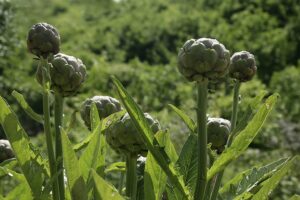Artichoke Growing Problems: Troubleshooting

Artichokes grow best in areas with long mild winters and cool summers. Artichokes do not grow well where the summers are sweltering, and where winters are cold and the ground freezes, artichokes must be replanted each year. Perennial artichokes should be cut back to about 12 inches in winter and the roots and crown heavily mulched with leaves or compost. For artichoke growing tips see Artichoke Growing Success Tips at the bottom of this post.
Common artichoke growing problems with cures and controls
Crowns of plant rot becoming slimy and foul smelling
Botrytis rot or crown rot is a fungal disease common in rainy weather. Remove and destroy infected plants. Keep weeds out of the garden where fungal spores may harbor.
Young stems chewed
Young earwigs feed on plant shoots and eat holes in foliage. Most often the damage is tolerable and the infestation is light. For heavy infestation, use traps of rolled wet paper or old flowerpots stuffed with paper to catch earwigs at night. Dump them in soapy water. Keep the garden free of plant debris. Spray with hot pepper and garlic repellent.
Jagged holes in leaves, stems
Snails and slugs scrape holes in foliage at night; they hide beneath boards and garden debris during the day. Handpick and destroy slugs and snails in the evening. Place saucers of beer at soil level to attract and drown snails and slugs. Dust with diatomaceous earth around plants.
Holes in stems and leaves; discolored spots on bracts
The larva of the artichoke plume moth is a ½-inch long green or yellowish caterpillar with black shield marks; the adult is a brownish moth with featherlike wings. Cut plants to soil level once a year; remove and destroy plant debris. Cover trimmed plants with 6 inches of soil. Using Bacillus thuringiensis and predaceous nematodes is effective.
Sticky honeydew on leaves and chokes; black sooty mold on the plant
Aphids are tiny, oval, and yellowish to greenish pear-shaped insects that colonize the undersides of leaves. They leave behind sticky excrement called honeydew which can turn into a black sooty mold. Spray away aphids with a blast of water from the hose. Use insecticidal soap. Control ants that farm aphids.
Curled leaves, dwarfed plants; chokes are small and misshaped; yield is reduced by nearly half
The curly dwarf virus is usually spread in propagation from infected plants, not seeds. Remove and destroy infected plants immediately. Use virus-free stock for new plants. Control aphids which spread many viruses.
The edible leaf bracts are tough and leathery
Summer heat can cause buds to open and leave the tissue tough. Harvest buds when closed tight and before they have started to open.
Artichoke growing success tips
Planting
Grow artichokes in full sun. Artichokes require well-drained soil rich in organic matter. Add aged compost to planting beds in advance of planting. Artichokes grow best where daytime temperatures do not exceed 70°F and nighttime temperatures do not fall below 55°F. In warmer regions, plant thornless artichoke varieties which are more heat resistant.
Planting time
Artichokes are most easily grown from bare-root divisions purchased from a nursery. Set divisions in the garden on about the average date of the last frost in spring. Artichokes also can be grown from seed; sow seed 8 weeks before the last expected frost in spring. Start seed indoors if you are growing artichokes as an annual crop.
Care
Perennial artichokes require a dormant period each year to trigger a new round of flowering the following year; this usually comes in the cool of winter. In warm winter regions, cut back plants to soil level when the foliage dies back after harvest. Do not water or feed plants during the dormant time. About 4 months later, dress the plants with compost and begin watering again; foliage will re-sprout and plants will produce new flower buds.
Annual artichokes do not require a long dormant period to promote flowering. Artichokes grown as annual should be exposed to a chilling period of 8 to 10 days before going into the garden. About two weeks before the average last frost date in spring, place annual artichokes in a cold frame where temperatures will stay above freezing but below 50°F. After the 10-day chilling period and after the last frost, transplant artichokes into the garden. ‘Imperial Star’ is a good annual artichoke choice for chilling.
Harvest
Perennial artichokes bud in spring. Annual artichokes produce flower buds in early summer. Cut buds before they open. Leave about 1 to 1½ inches of stem attached to each bud.
More articles of interest:
How to Plant and Grow Artichokes
How to Harvest and Store Artichokes
Artichoke Growing Problems: Troubleshooting
How to Cook and Serve Artichokes
Vegetable Garden Diseases Problem Solver
Vegetable Garden Organic Weed Control
Garden Planning Books at Amazon:
- Vegetable Garden Almanac & Planner
- Kitchen Garden Grower’s Guide Vegetable Encyclopedia
- Vegetable Garden Grower’s Guide
- Tomato Grower’s Answer Book







